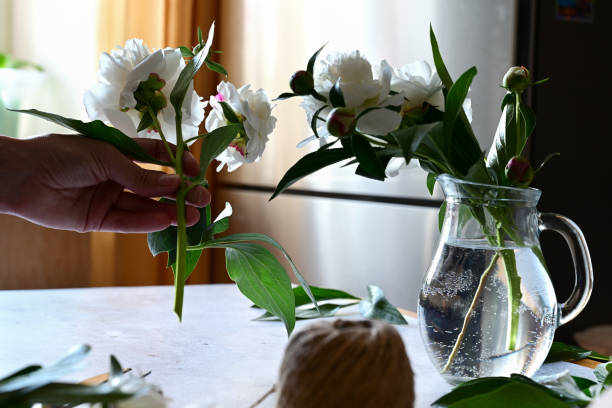Floral aficionados and casual enthusiasts alike delight in the vibrant splash of color and fragrance that flowers bring into our lives. The main challenge, once these blooms are cut and styled into fetching bouquets, is maintaining their crisp, just-picked appearance. The secret to longevity lies in professional florists’ tricks, common household ingredients, and a touch of science that work cohesively to preserve the vase life of cut flowers. In this comprehensive guide, we’ll dive into various techniques and additives that could help your arrangements looking fresh and lasting longer, ensuring those blooms will not wilt prematurely.
The Science Behind Fresh Flowers
Upon being cut, flowers, having lost their natural source of nutrients, continue their survival by absorbing water through their stems. This water, ideally, should be full of dissolved sugars which act as a substitute for the nutrients they’d normally get from their roots. However, contamination by bacteria or fungi can block the stems from absorbing water efficiently, leading to a swift decline in freshness. Including certain additives in the water can create an environment that helps keep such microorganisms in check, thereby extending the lifespan of your floral arrangements.
Flowers food plays an indispensable role by not only providing nourishment but also keeping the water acidic which allows for better water uptake through the stem. This tricks the cut flowers into thinking they are still growing, thus they will last longer. It is a delicate balance; too much of certain additives could harm them, while too little will not be effective.

Essential Additives for Your Flower Water
Homemade Solutions
- A teaspoon of sugar mixed with a few drops of bleach is as useful as any commercial product, with the sugar feeding the flowers and the bleach keeping the water clear of bacteria.
- Combining two tablespoons of apple cider vinegar with two tablespoons of sugar can also do wonders. You should be sure to change the water every few days, adding a fresh dose of the mixture.
- The secret ingredient hiding in your fridge, lemon-lime soda, could help maintain floral freshness. By using one-fourth of a cup mixed with water in a cleaned vase, your cut flowers will benefit from the soda’s sugar and acidity.
Commercial Preservatives
For those who prefer convenience, commercial floral food packets are readily available and tailored to make bouquets last longer. These packets contain a balanced mix of sugar, acidifier, and bleach to nourish the flowers, keep the pH level optimal, and prevent bacterial growth. Using these preservatives as directed will ensure the flowers will stay vibrant.
| Additive Type | Ingredients | Frequency of Water Change | Benefits |
|---|---|---|---|
| Homemade | Sugar, Bleach, Vinegar, Lemon-Lime Soda | Every 2-3 days | Cost-effective, Easy to make |
| Commercial | Sugar, Acidifier, Bleach or similar disinfectant | As per the packet’s instructions | Professionally balanced, Long-lasting effect |

Common Mistakes to Avoid
Even with the best intentions, certain missteps could diminish the vase life of your blooms. One of the most common errors is overcrowding the vase. When too many stems are packed into a vase, the restricted airflow can lead to the rapid growth of bacteria and fungi. It can also cause stems to crush one another, which will impede their ability to absorb water properly and eventually detract from the overall look of the arrangements looking.
Another mistake is using dull cutting tools. Always ensure that your tools are sharp; dull tools will crush the vascular system of the stem, making it difficult for flowers to absorb water. This often leads to a quicker demise for the cut flowers. Furthermore, the quality of the water added to the vase significantly influences flower health. Tap water is adequate in most cases, but for optimal results, use filtered or purified water since it contains fewer chemicals that could potentially harm delicate blooms.
Advanced Tips for Specific Flower Types
- Tailoring water additives based on flower species – Each species may require different types of care. Researching the specific needs of your flowers or consulting a florist could prove beneficial.
- Special considerations for mixed bouquets – Mixed bouquets should cater to the most sensitive flowers, and considerations like ethylene production should be taken into account to avoid premature wilting.

Conclusion
Keeping your cut flowers looking fresh and vibrant for an extended period is a blend of art and science. By using household items or commercial preservatives judiciously, maintaining a routine of changing the water and trimming the stems, and taking into account the particular needs of different flower species, you can significantly enhance the staying power of your floral arrangements. It’s these thoughtful measures, along with avoiding common care mistakes, that culminate in bouquets that radiate beauty and joy for days or even weeks. Remember, the care you take in the first days after bringing your flowers home will help set the stage for their lasting beauty.
FAQs
- Should I always use warm water for my flowers?
In most cases, warm water improves the flower’s uptake of nutrients, but for delicate flowers, lukewarm water is preferable. - How often should additives be changed in the water?
Ideally, when you change the water every two to three days, you should also add fresh additives. - Can I use the same additives for all types of flowers?
No, some flowers may require specific care, so do some research or consult a florist about your particular bouquet. - Is it harmful to mix homemade solutions with commercial preservatives?
Yes, generally you should not mix these as they are both balanced to work on their own. - What is the best way to tell if a flower is no longer fresh?
Look out for signs such as wilting, drooping petals, discoloration, and murky vase water.
